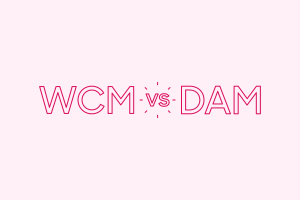WCM vs. DAM: Differentiating Between Web Content Management and Digital Asset Management

If you find the boundaries between digital asset management (DAM) and web content management (WCM) software a little murky, you’re not alone. After all, in the wildly diverse landscape of 9,000+ marketing technology (martech) vendors, these two systems both focus on managing digital content.
This overlap might make it difficult to decide which platform is best for your team. But understanding your needs upfront — along with the benefits of each solution and how they can play together — will help justify your purchase and meet your business goals.
What is web content management (WCM)?
|
A web content management, or WCM, system is used to maintain, control, and edit content on webpages. Its tools allow users to create and manage web content with little or no knowledge of programming languages, though understanding some basic coding principles helps. |
WCM software is a subsection of content management that specifically focuses on the web. The Association for Information and Image Management (AAIM) lists its key features as:
- The ability to design and organize websites
- The ability to control and prepare content for publication
- The automation of key parts of the publishing process
Some WCM platforms also include a media management offering for organizing the web content.
How is WCM different from DAM?
Both WCM and DAM systems store and manage digital content, and have tools to review and approve content as it is prepared for publication.
However, there are several significant ways that WCM and DAM are different. For example:
- Content structure: In a DAM system, metadata is applied to every asset to facilitate easy searching and downloading. While a WCM system can show you where a file is used on a website or blog, it doesn’t use metadata to organize content.
- Content distribution: WCM systems are designed to publish content to the web, including the organization and storage of actual web pages. However, a DAM system distributes content to multiple endpoints via various channels. It allows you to share, embed, download, and convert files securely with advanced permissioning features.
- Content sharing: The content housed in a WCM system is used to create websites. DAM systems, on the other hand, store content for a range of uses and stakeholders. And they have security and permission tools to control which assets are available to different user groups. So with a DAM solution, both internal teams and external partners can access the system to find and download the content they need.
- Content transformation: WCM platforms offer a repository for rich media (images, audio, video, etc.), while DAM systems are designed to store, preview, and transform rich files into versions that are optimized for web or print use. The ability to convert files from within the system eliminates the need to store multiple versions, saving space and reducing the margin of error since only one asset needs to be updated.
Advantages of DAM over WCM?
If an organization is looking for a solution that will give users the ability to create websites and store the related content, WCM systems are the way to go.
However, if the goal is to find a solution that will serve as the content hub across a martech stack, then DAM offers numerous advantages over WCM. Here are a few:
- Bring content together: Create a centralized, searchable library of your photos, videos, documents, podcasts, and product information to eliminate bottlenecks and encourage proper use and reuse of assets.
- Empower and control: Give teams the ability to self-serve content while maintaining control of your brand across channels, to improve brand management processes.
- Leverage powerful data analytics: Track asset activity — including embed views, shares, and downloads — to understand how your content is being used and inform strategy decisions.
Does it have to be either or?
After reviewing the technical strengths of both DAM and WCM systems, you might realize that your team really needs both. After all, they are very different tools. But the good news is that the two systems can work together to bring valuable efficiencies across workflows.
An integration between DAM and WCM platforms allows creative content stored in the DAM site to be seamlessly pushed to the WCM system. So, for example, if a file on your website needs to be updated, simply uploading the newest version to the DAM solution will automatically publish it online.
Acronyms a plenty
The martech world has no shortage of categories, vendors, and acronyms! With many players in the same crowded, digital space, it’s no wonder that there are some similarities. But when it comes to WCM and DAM systems, the differences between the functionality are clear. And if you are looking for a powerful central content hub for your entire martech stack, an investment in DAM could pay dividends.
To learn more about our enterprise digital asset management system, Acquia DAM (Widen), request, watch, or click through a demo today.
Note: This article was originally published on Widen.com.



